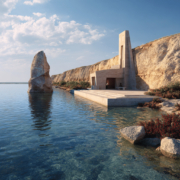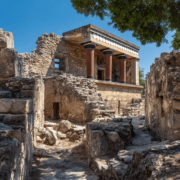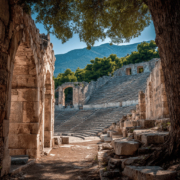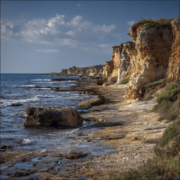Unveiling the Mysteries of Knossos: A Journey Through Ancient Crete
When it comes to exploring ancient ruins, few places can compare to the island of Crete in Greece. Home to the legendary Minoan civilization, Crete is a treasure trove of history and culture waiting to be discovered by intrepid travelers.
One of the must-visit sites on the island is the ancient palace of Knossos, located just outside the capital city of Heraklion. This archaeological wonder offers visitors a unique glimpse into one of Europe’s most sophisticated Bronze Age civilizations.
Stepping Into Ancient History
As visitors wander through the labyrinthine corridors and rooms of Knossos, they can’t help but feel a sense of awe at the sheer magnitude of this once-great palace. The intricate frescoes, grand staircases, and massive columns all speak to the advanced civilization that once thrived here over 3,000 years ago.
The palace complex covers approximately 20,000 square meters and was likely the ceremonial and political center of the Minoan civilization. Archaeological evidence suggests that the site was continuously inhabited from the Neolithic period through the Roman era, making it one of the most significant historical sites in the Mediterranean.
It’s easy to imagine the bustling activity that would have taken place within these walls thousands of years ago – from religious ceremonies in the sacred areas to administrative duties conducted in the various chambers and storage rooms that housed the wealth of this maritime empire.
Making the Most of Your Knossos Experience
To make the most of a visit to Knossos, travelers should plan to arrive early in the morning to beat the crowds and the Mediterranean heat. The site opens at 8:00 AM during peak season, and early visitors often enjoy a more peaceful and contemplative experience among the ruins.
Visitors should take their time exploring each section of the palace, from the famous throne room with its ancient gypsum throne to the extensive storerooms that once held giant pithoi (storage jars) containing olive oil, wine, and grain. Don’t miss climbing to the top of the grand staircase for a panoramic view of the surrounding Cretan countryside.
Comfortable walking shoes are essential, as explorers will be doing a fair amount of walking and climbing on uneven ancient stones. Bringing plenty of water is also crucial, especially during the warmer months when temperatures can soar.
Discovering Minoan Mysteries
One of the most rewarding aspects of visiting Knossos is the opportunity to learn about the fascinating history of the Minoan civilization. This Bronze Age culture was remarkably advanced, featuring sophisticated plumbing systems, multi-story buildings, and extensive trade networks throughout the Mediterranean.
Many visitors choose to take a guided tour to gain a deeper understanding of the palace’s layout and historical significance. Knowledgeable guides can explain the complex reconstruction work done by archaeologist Sir Arthur Evans in the early 20th century and help distinguish between original Minoan elements and modern reconstructions.
Alternatively, visitors can wander at their own pace with an audio guide, allowing them to soak in the atmosphere and contemplate the mysteries that still surround this ancient civilization. The legend of the Minotaur and the labyrinth adds an extra layer of intrigue to the experience.
Extending the Cultural Journey
No visit to Knossos would be complete without exploring the nearby Heraklion Archaeological Museum. This world-class museum houses an extensive collection of artifacts from Knossos and other Minoan sites across the island, including the famous Snake Goddess figurines and intricately crafted gold jewelry.
The museum provides crucial context for understanding daily life in ancient Crete and showcases the remarkable artistic achievements of the Minoans, from delicate pottery to elaborate wall paintings that once decorated the palace walls.
Beyond the Ruins: Embracing Modern Crete
After immersing themselves in ancient history, visitors can transition to enjoying the contemporary pleasures that Crete has to offer. The island boasts some of the Mediterranean’s most stunning beaches, where travelers can swim in crystal-clear waters and unwind after a day of exploration.
The nearby Cretan cuisine provides another compelling reason to extend the stay. Local tavernas serve fresh seafood, locally produced olive oil, and traditional dishes like dakos (Cretan rusks with tomatoes and cheese) and lamb with stamnagathi (wild greens). Many of these establishments offer seaside dining with spectacular sunset views.
Whether visitors are history enthusiasts, beach lovers, or culinary adventurers, Crete offers a perfect blend of ancient wonders and modern pleasures. The island’s rich archaeological heritage, combined with its natural beauty and warm hospitality, creates an unforgettable destination that appeals to travelers of all interests.
From the mysterious corridors of Knossos to the sun-soaked beaches of the Aegean, Crete invites exploration and promises discoveries that will resonate long after the journey ends. This ancient land continues to reveal its secrets to those curious enough to seek them out.











